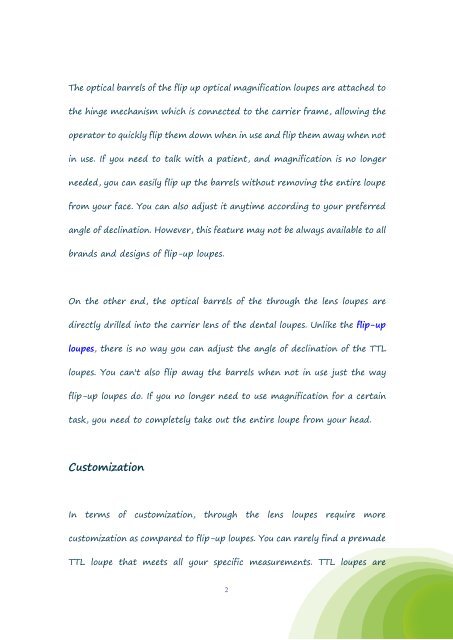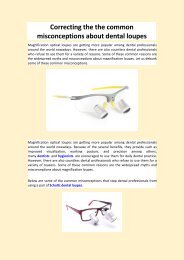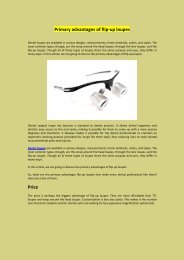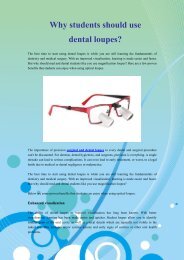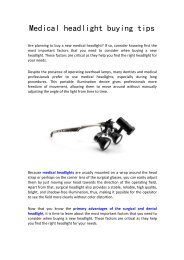Differentiating flip-up loupes and through the lens loupes
Dental loupes are available in various designs, types, and styles but the two most common types are the flip-up loupes and the through the lens loupes. Though they share the same purpose and use flip-up loupes and through the lens or TTL loupes differ from each other in many ways.
Dental loupes are available in various designs, types, and styles but the two most common types are the flip-up loupes and the through the lens loupes. Though they share the same purpose and use flip-up loupes and through the lens or TTL loupes differ from each other in many ways.
You also want an ePaper? Increase the reach of your titles
YUMPU automatically turns print PDFs into web optimized ePapers that Google loves.
The optical barrels of <strong>the</strong> <strong>flip</strong> <strong>up</strong> optical magnification lo<strong>up</strong>es are attached to<br />
<strong>the</strong> hinge mechanism which is connected to <strong>the</strong> carrier frame, allowing <strong>the</strong><br />
operator to quickly <strong>flip</strong> <strong>the</strong>m down when in use <strong>and</strong> <strong>flip</strong> <strong>the</strong>m away when not<br />
in use. If you need to talk with a patient, <strong>and</strong> magnification is no longer<br />
needed, you can easily <strong>flip</strong> <strong>up</strong> <strong>the</strong> barrels without removing <strong>the</strong> entire lo<strong>up</strong>e<br />
from your face. You can also adjust it anytime according to your preferred<br />
angle of declination. However, this feature may not be always available to all<br />
br<strong>and</strong>s <strong>and</strong> designs of <strong>flip</strong>-<strong>up</strong> lo<strong>up</strong>es.<br />
On <strong>the</strong> o<strong>the</strong>r end, <strong>the</strong> optical barrels of <strong>the</strong> <strong>through</strong> <strong>the</strong> <strong>lens</strong> lo<strong>up</strong>es are<br />
directly drilled into <strong>the</strong> carrier <strong>lens</strong> of <strong>the</strong> dental lo<strong>up</strong>es. Unlike <strong>the</strong> <strong>flip</strong>-<strong>up</strong><br />
lo<strong>up</strong>es, <strong>the</strong>re is no way you can adjust <strong>the</strong> angle of declination of <strong>the</strong> TTL<br />
lo<strong>up</strong>es. You can't also <strong>flip</strong> away <strong>the</strong> barrels when not in use just <strong>the</strong> way<br />
<strong>flip</strong>-<strong>up</strong> lo<strong>up</strong>es do. If you no longer need to use magnification for a certain<br />
task, you need to completely take out <strong>the</strong> entire lo<strong>up</strong>e from your head.<br />
Customization<br />
In terms of customization, <strong>through</strong> <strong>the</strong> <strong>lens</strong> lo<strong>up</strong>es require more<br />
customization as compared to <strong>flip</strong>-<strong>up</strong> lo<strong>up</strong>es. You can rarely find a premade<br />
TTL lo<strong>up</strong>e that meets all your specific measurements. TTL lo<strong>up</strong>es are<br />
2


